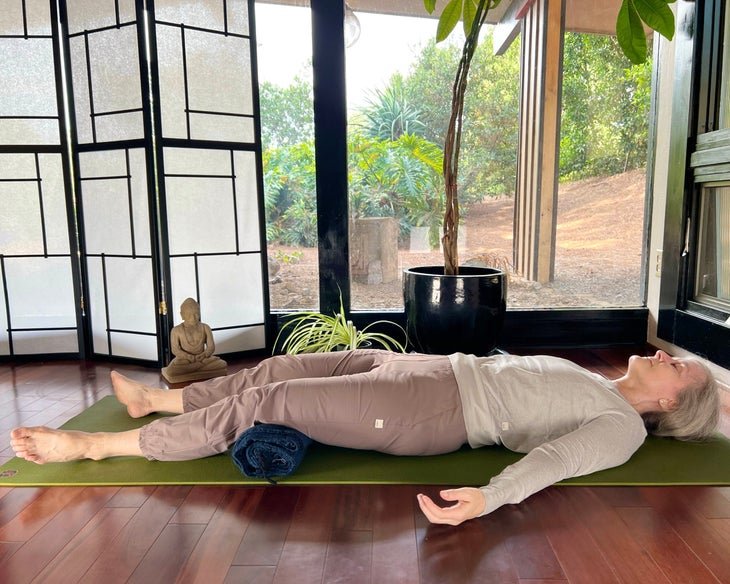“], “filter”: { “nextExceptions”: “img, blockquote, div”, “nextContainsExceptions”: “img, blockquote, a.btn, a.o-button”} }”>
Some yoga students anticipate Savasana so eagerly, they are in the pose even before class ends. I’ve even had students jokingly request an hour-long Savasana at the beginning of a vinyasa class. But others feel it is “the most challenging” yoga pose. It offers a deep stillness that many of us rarely achieve; for people who like to stay on the go, it can be downright uncomfortable.
Whatever your personal relationship with Savasana, this pose remains synonymous with relaxation in yoga. What better way to celebrate National Relaxation Day on August 15, than to explore variations on Savasana. This is a perfect reminder to set aside time to relax—and to do so intentionally.
What does it mean to relax?
Many of us think of relaxing as watching TV, reading a book, cooking, or spending time with friends. However, in these activities, our brains are still highly active, and we don’t always find the rest and recharge we actually need.
Indeed, purposeful relaxation is “an opportunity for the brain to make sense of what it has recently learned, to surface fundamental unresolved tensions in our lives and to swivel its powers of reflection away from the external world toward itself,” according to research quoted in Scientific American. The goal of relaxation is not to distract ourselves, but rather to set a deliberate intention to release stress while completely inhabiting the moment. When you make the conscious choice to let go in your body, your mind follows, and vice versa.
The Three B’s: Bolsters, Blankets, Blocks
You may have seen those funny videos in which the earnest yogi uses every prop in the studio to set up for one pose. But it’s not a joke; it works! When it comes to Savasana, or any restorative pose, there are no rules except to find as much calm as possible. A key element to relaxation is to make sure the body feels supported and comfortable. For Savasana, I encourage my students to use the “3 B’s”: blankets, bolsters, and blocks. When it comes to props, Use as many as you like! If they help make you more comfortable, use all of them!
Here are six fresh ideas for purposefully inviting relaxation into your Savasana.
6 ways to explore Savasana’s potential for ultimate relaxation
Savasana with supported knees
Lying down with straight legs may be uncomfortable for some people because it can put pressure on the lower back. Bending your knees when you’re in a reclined position can take pressure off the lower back, and allowing your knees to naturally roll outward keeps the adductor muscles in the thighs from overworking. Roll a blanket or a bolster and place it under your knees to create more ease in your whole body and relieve any back discomfort. You can also place folded blankets under your head and neck. When your neck and lumbar spine feel fully supported, the rest of your body can soften easily into relaxation.
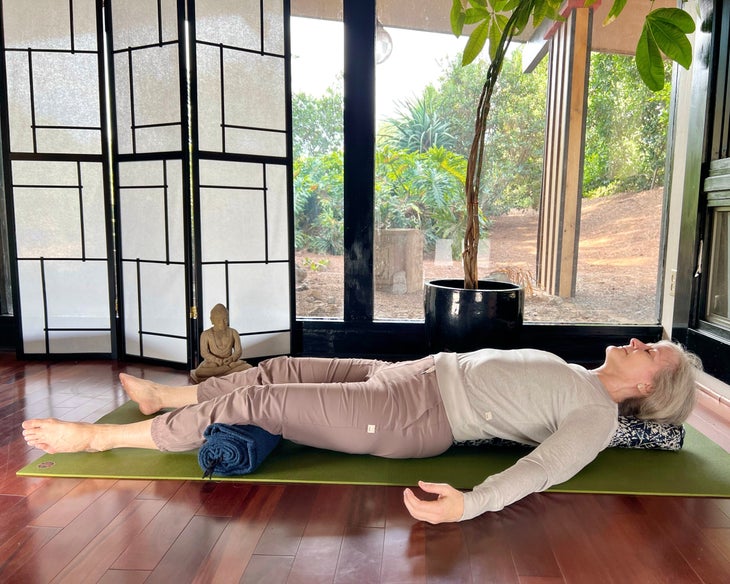
Savasana reclined on a roll
As is the case with any yoga pose, sometimes a slight alteration can create more ease in the body, and Savasana is no exception. Lying lengthwise on a slim bolster or rolled blanket can provide openness in the shoulders and heart and lengthen the spine. Position the roll so that the end of it is at the base of your spine and extends the length of your back, neck, and head. Don’t forget to keep your knees supported to take any pressure off the lower back.
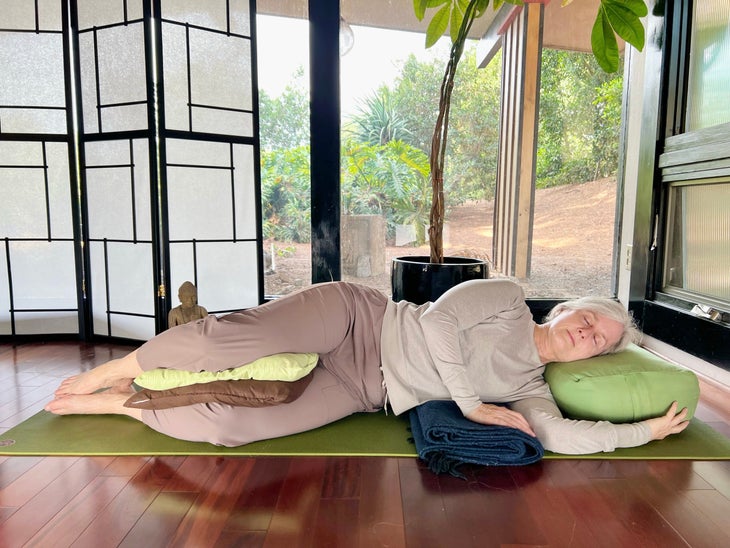
Savasana resting on your side
Wait, you mean you don’t have to lie on your back for Savasana? Absolutely not. Sometimes, breaking the “rules” is just what you need, especially if lying on your back causes discomfort. (People who are late in pregnancy will be able to relate.) Savasana is supposed to be restful, and if you feel more comfortable on your side, that’s the pose for you! Feel free to place blankets or bolsters between your knees, under your chest and arms, and/or under your head for support. These supports help keep the spine aligned and the hips level in a side-lying Savasana.
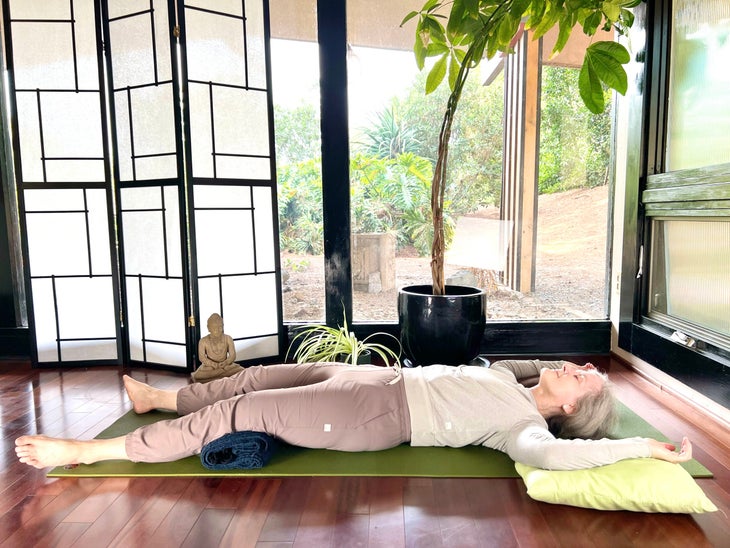
Savasana with arms overhead
Traditionally, Savasana is performed on your back with your arms beside your torso and palms facing up. Reaching your arms overhead—out in a V shape or with your elbows bent in cactus arms—is a nice way to gently stretch the pectoralis muscles at the front of your chest and open the rib cage while you rest. For more comfort, place a bolster or blankets under your elbows and forearms to support your shoulder joints.

Downward-facing Savasana
When I said it was ok to break the rules, I meant it! This is a prone Savasana variation, and it’s a particularly welcome variation if you feel discomfort when lying on your back. To do this comfortably, you’ll want to gather plenty of blankets, bolsters and pillows to support your joints and cushion the front of your body. I recommend using a bolster under your belly and chest for this prone asana. Then, with the bolster underneath your torso and chest, support your forehead with a pillow, blanket, block or all of the above. This setup gives your space to breathe and keeps you from over-extending your back.
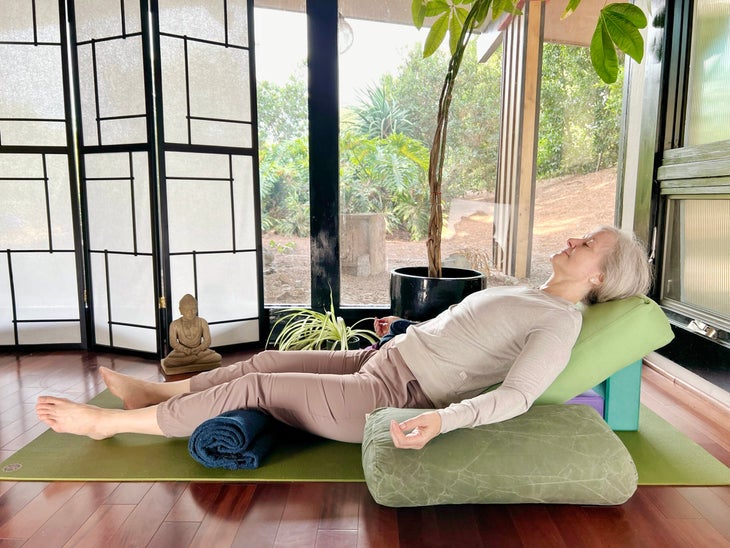
Elevated Savasana
Elevating the head and chest in Savasana is another option for people who may feel uncomfortable lying flat on their back. This is especially beneficial for anyone experiencing congestion, and is another position suitable during pregnancy. In this restorative pose, use blocks—as many as you need—underneath the bolster to create an incline for your head, neck and torso. Be sure to have a sticky mat underneath you so the blocks don’t shift. Then sit with the end of your bolster at the base of your spine so that when you recline, the bolster supports your lumbar spine. More bolsters or a stack of folded blankets or pillows can support your arms. If you want more opening across your chest and shoulders, skip the props and allow your hands to rest on the floor. Roll a blanket or use a narrow bolster under your knees.

